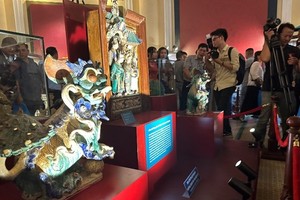The Information and Culture Board, under the HCMC Committee of the Party, recently introduced a new book, "A Brief History of the Southern Land of Viet Nam". In reference to this book, Associate Dr. Phan Xuan Bien, Director of the HCMC Social Research Institute, gives his opinion on the important role of the book in heightening the people’s awareness of national origin and Viet Nam’s historical development.

The process of extending Viet Nam’s territory to the south was a great landmark in our country’s history; however, historians have not yet compiled a formal set of national level history books outlining the establishment and historical development of the land.
Recent scientific historical studies, especially archaeological and anthropological studies, have proven that a new, more scientific and reliable outlook on the historical development of the country and the people of the southern land is needed. Early subjective hypotheses, based on speculation as apposed to scientific evidence, used to be widely accepted; however, with advancing scientific research these hypotheses are now being disproved.
It has been discovered that hundreds of centuries BC, ancient and primitive people lived together in this populous and rich land, mainly in the Southeastern areas of Viet Nam, in the lower sections of the Dong Nai and Sai Gon Rivers, and along the banks of the Vam Co River.
Early AD, the ancient peoples gradually moved down to the Southwest and integrated with the existing Mayayo - Polynesian community. Together the people built the Kingdom of Phu Nam, what was once a powerful country of affluent villages and prosperous cities. After five or six centuries of living in this golden era, the kingdom collapsed due the impact of numerous social and natural forces.
A large proportion of the population moved back to their old land and continued living by primitive means of hunting and trapping and tilling the fields on the mountain slopes. Their descendants, the Ma, Chau Ro and Stieng peoples still live in the south of the Central Highlands and in the southeast of Viet Nam.
After the collapse of the Phu Nam Kingdom, the Mekong Delta remained deserted for nearly ten centuries. It was not until the seventeenth century, when the Kinh people set foot in the region and settled down on the land, transforming it into a cultivated area, that the Mekong delta became a populous region where people of the different Kinh, Khmer, Chinese and Cham ethnicities, lived together in harmony.
These new concepts have only recently been circulated amongst specialists, and it may be some time before the majority of people change their view on the history of the south, instead they continue to believe the outdated hypotheses that distort the truth, driving a wedge between the peoples.
The publication of the book aims to give the general public access to these new concepts in order to build on the strength of our great national unity. It is necessary to popularize these concepts through education and the mass media in order to help the people to become more aware of both theories.
























